The Checker Maven
Zig-Zag
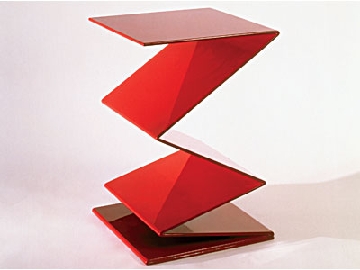
The term zig-zag is of uncertain origin. It seems to have first appeared in print in a Dutch publication in 1706; it appeared in English around 1728. It is probably a variation of the German word "zickzack." This word evidently referred to castle fortifications, which were often built in a zig-zag form; the word "zick-zack" was also used in English, along with "zic-zac," until "zig-zag" seemed to become the standard--- if such things really have standards.
Today's checker problem definitely has a zig-zag nature, as can be seen in the diagram below.
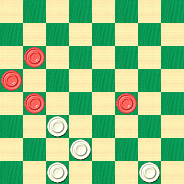
WHITE
White to Play and Win
W:W22,26,30,32:B9,13,17,19.
This is supposed to be an easy problem, but in fact it requires some thought. Can you make those pieces zig and zag to a White win? Give it a try and then zig-zag your mouse over to Read More to see the solution.![]()
Down On The Farm (Team)
Marvin J. Mavin found himself at Fifty-Third Stadium in Comstock Park, Michigan, playing fifth board for the West Michigan Wompers in a matchup with the Great Lakes Glommers, in the single A Midwest League.

Checker Fans at Fifty-Third Stadium, Comstock Park, Michigan
Yes, that's fifth board and Single A. Just how such a turn of events came about is a bit of a story.

Marvin J. Mavin
It all started when Marvin, the usual Captain and first board player for the Detroit Doublejumpers, an outstanding Major League team, was called into the team manager's office. The manager, tired of Marvin embarrassing the team with his beer-drinking antics, was in the mood of teaching Marvin a lesson. But Marvin had been foolish enough to have had a couple of beers at lunch and started calling his boss a few uncomplimentary names as the boss was attempting to lay down the law.
That's when the manager drew the line. No one, even a star player, had the right to be insubordinate and rude, much less engage in behavior that provided a bad example to the team's younger fans. The manager decided that Marvin should be sent down, not even to the AAA or AA level of Detroit's farm team system, but all the way to the Single A level, giving him time to contemplate the error of his ways. To further ensure that Marvin got the message, he was to play fifth board--- the lowest slot on the team.
Marvin, to say the least, was not very happy. That, his manager told him, was exactly the point. Furthermore, Marvin would remain with the farm team until he improved both his attitude and behavior, or lacking that, was fired altogether.
"You have no more than a month to shape up," the manager said, "or your career in professional checkers is over."
And so Marvin was sitting across the board from Chester Schlockovitz, fifth board player for the Glommers. Chester was a nice enough old guy. He had never risen higher than Single A checkers but somehow had hung on for 35 years or so in the lower rungs of the professional ranks. He wasn't a has-been so much as a never-been, but you had to admire his persistence.

Chester Schlockovitz
Marvin, to his chagrin, was being made to pass a breathalyzer test before each game to ensure that he had been staying away from the beer. The coach of the Wompers, Thaddeus Twizzler, was strict with the players and Marvin's superstar status didn't earn him any slack in Thaddeus's eyes. Marvin would follow the rules just like anyone else and that meant no drinking during the playing season, period. Thaddeus was adamant. "Drinking ain't never done no one no good, and they sure don't play checkers right if'n they do drink," he would often say.

Thaddeus Twizzler
So here Marvin was, facing Chester over the board. "Nice afternoon, city boy," Chester said, "reckon you can beat me at this here game?" It was clear that Chester, in his plain-speaking manner, meant this as a friendly sort of challenge.
Marvin didn't reply; the starting whistle had blown, and Chester, playing Black, fell silent and made his first move. The game played out as shown below.
| BLACK | WHITE | |
| Chester | Marvin | |
| 1. | 9-13 | 22-18 |
| 2. | 12-16 | 24-20 |
| 3. | 8-12 | 28-24 |
| 4. | 4-8 | 18-14 |
| 5. | 10x17 | 21x14 |
| 6. | 16-19 | 24x15 |
| 7. | 11x18 | 26-22 |
| 8. | 7-11 | 22x15 |
| 9. | 11x18 | 14-10 |
| 10. | 6x15 | 23x14 |
| 11. | 3-7 | 25-22 |
| 12. | 1-6 | 22-17 |
| 13. | 13x22 | 31-26 |
| 14. | 22x31 | 32-28 |
| 15. | 31x24 | 28x3 |
"Well, how d'ya like them apples!" Chester chuckled cheerfully. "You ain't a bad player for one a them there city fellas!"
| 16. | 6-9 | 14-10 |
| 17. | 9-14 | 29-25 |
| 18. | 5-9 | 20-16 |
| 19. | 12x19 | 3x12 |
| 20. | 19-23 | 12-16 |
| 21. | 23-27 | 16-19 |
| 22. | 27-31? |
Marvin, in a brief moment of feeling, looked over at Chester with a sad expression. Chester had played a fine game up to this point, but it was moves such as this that separated the Major Leaguers from the also-rans. Marvin now had a clear win, and he knew it.

WHITE (Marvin)
White to Play and Win.
W:W30,25,K19,10:BK31,14,9,2.
Can you match wits with Marvin and find the win, or will you be sent down to the farm team too? Give it your best--- your professional checker career may depend on it--- and then click on Read More to see the solution and the rest of the story. While you're at it, correct Chester's losing move, too.![]()
Grand Reopening

Our offices are open again and we're returning to business as usual. We're glad to be back!![]()
The Laboring Gardener

The gardener in the photo above is doing things the old-fashioned, laborious, long and hard way. Sometimes that's the only way to get the job done; in life and in checkers alike there isn't always a short-cut and there isn't always an "easy" way.
Today's lesson in our Checker School series is attributed to a Mr. W. Gardner (not "Gardener" although it's close enough for us). There are actually two solutions to the problem; there's the originally published solution, and an alternative. The alternative is long and tough, but the main solution is only a little less so. In short, this one has to be done the hard way, with much patience, effort, skill and perseverance. Here's the situation.
WHITE
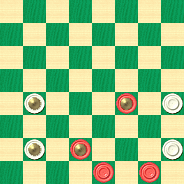
BLACK
Black to Play and Win
B:WK16,13,K8,5:BK14,K7,2,1.
If you think this isn't an easy position to win, you're right, but it can be done. Stick with it, work at it, hoe away until the ground is cleared; then rake your mouse over Read More to see the original solution, a new solution, two sample games, detailed notes and a special sidebar about a checker-playing robot.![]()
Cowan's Coup

When we think of a coup our image is often of one like Napoleon's coup d'etat in November, 1799, as shown above. Certainly, while a coup can be peaceful, alas, it is often anything but. So we've got to be grateful that while les coups can and do take place on the checkerboard, and they may seem rather violent in a checkeristic fashion, nothing is lost except a few pieces of wood or plastic, and even those return alive and well for the next game.
Willie Ryan, in his book Tricks Traps & Shots of the Checkerboard, shows us many a coup. Today, he'll demonstrate one associated with a Mr. Cowan. Let's take a look.
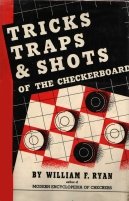
| 9-14 | 7-11 | 2-7 |
| 22-18 | 25-22 | 30-26 |
| 5-9 | 10-15 | 7-14 |
| 24-19 | 19-10 | 26-23 |
| 11-15 | 6-15 | 3-7 |
| 18-11 | 27-24 | 24-20 |
| 8-24 | 16-20 | 7-10---1 |
| 28-19 | 23-19 | 32-28 |
| 4-8 | 20-27 | 1-5 |
| 25-22 | 19-10 | 22-18 |
| 8-11 | 14-23 | 5-9 |
| 22-18 | 26-19 | 28-24 |
| 11—16 | 9-13* | 13—17---A,2 |
| 29-25 | 31-24 | Now you have |
| reproduced the diagram. |

WHITE
White to Play and Draw
W:W24,23,21,20,19,18:B17,14,12,11,10,9.
A---"In 1882, a noted player by the name of M. Cowan, of Whitehaven, England, published the position on the above diagram as a problem. In 1894, Fred S. Hogue, of San Francisco, published the above game, showing how Cowan's "landing" came up in actual play. When Hogue's opponent, playing white, reached the diagrammed setting, he resigned, believing his position hopeless. Suffice it to say that Cowan's Coup may be brought up in play from many different openings. Accordingly, every student of the game must train himself to recognize or anticipate it when it looms on the board."
1---Just about straight "book" play up to this point, where the KingsRow book ends and calls the position dead even---Ed.
2---Pretty much flawless play on both sides. Black appears to have an advantage, but it's an illusion, as the solution will show---Ed.
Will you be overthrown by this problem, or can you carry out the coup? When you've worked out the answers, click on Read More for the revolutionary solution.![]()
Fourth of July Special

Every year we celebrate the 4th of July. As unabashed and unapologetic patriots, it's one of our favorite holidays. America is a great nation, the American people are a great people, and we're proud to honor our country on its birthday.
We won't go quite so far as to say that checkers defines the American character, but as we've said before, there's a democratic side to checkers that appeals to us. Anyone can play and anyone can succeed. It's just a matter of how hard they're willing to work.
America has produced great checkerists such as Marion Tinsley, Asa Long, and many more. But when it comes time to publish an American checker problem, as we're wont to do for the week of 4th of July, we usually turn to all-around great Tom Wiswell. Today is no exception as we present a Wiswell composition that is as elegant as it is difficult. It was originally published under the title The Rainbow.
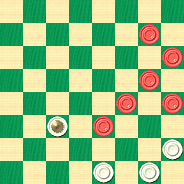
WHITE
White to Play and Draw
W:W32,31,28,K22:B23,20,19,16,12,8.
Mr. Wiswell stated that this problem requires White to make no less than 12 "star" moves (a star move is the only move that will work in a given situation), and little wonder; White is down not one but two pieces. We're setting a tough task here, but we can guarantee that it will be worth the time and effort. Give it your best, and then give it some more, and don't give up. When you're finished, click on Read More to see the solution.![]()
